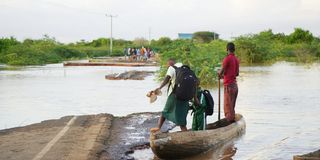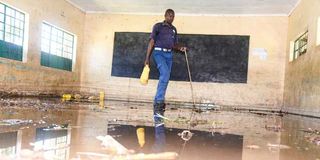
Students disembark from a canoe to school at Watta Hamesa village, Tana River County on Monday May 13.
With schools reopening today for the second term, education stakeholder want the government to put stringent measures to ensure the safety of thousands of learners.
Initially, basic education institutions, comprising Early Childhood Development and Education (ECDE) centres, primary and secondary schools were supposed to be reopened on April 29, but this was pushed to May 6 due to the raging floods that destroyed school infrastructure.
The Kenya National Union of Teachers (Knut) has, however, expressed concerns about the reopening of schools, urging the government to first address the infrastructural challenges caused by floods.
Knut First National Vice-Chairman Malel Langat said the government should have postponed the reopening for a few days so as to improve the infrastructure in the institutions.
“We find ourselves in a very precarious situation,” said Mr Alfred Rop, adding that stakeholders in the sector are concerned about the safety of learners as flood waters have either marooned the institutions or destroyed infrastructural facilities.
“Toilets, classrooms, laboratories, dormitories, staff rooms and teachers quarters are either submerged or have been destroyed,” Mr Langat said on Saturday during the training of Branch Executive Committee members for Knut’s Chepkoilel branch in Uasin Gishu County.
Mr Langat said thousands of schools had been affected, while urging the government to repair damaged infrastructure such as roads and bridges.

A security guard wades through a flooded classroom at Muslim Primary School in Nakuru yesterday.
“Instructional materials, including books, laptops, computers, tablets, chalk and projectors, and foodstuff in stores have been destroyed by the floods,” Mr Langat stated.
In the North Rift region, clerics led by Bishop Zablon Malema of Haleluya Church in Eldoret, Uasin Gishu County, said parents are worried about the safety of their children in areas affected by floods.
“The State should give schools more time to restore the infrastructure that was destroyed by floods,” said Bishop Malema. God, he said, will help the country to overcome the floods just like He did during the Covid-19 pandemic.
“It is interesting to note that the Kenya Certificate of Primary Education exam candidates of 2020 who were affected by Covid-19 have also been affected by floods in their Kenya Certificate of Secondary Education exam year,” said Bishop Malema.
Adversely affected
Council of Imams and Preachers of Kenya Chairman Sheikh Abubakar Bini challenged the government to ensure that the areas that were adversely affected by floods are given special attention to ensure the safety of learners.
Sheikh Bini further urged well-wishers to help parents and schools that were adversely affected by floods.
“We should all support the government to ensure that learners go back to school. But we should not risk their lives in areas that are still experiencing floods such as Budalang’i in Busia County, Tana River County among others,” said Sheikh Bini.
In Busia, 10 schools in Bunyala South, Bunyala Central and Bunyala North wards have been rendered uninhabitable by floods. The schools are all submerged with their walls showing signs of weakening.
The flooding has been caused by the backflow from Lake Victoria.
Busia County Director of Education James Ekalyio said 10,000 learners in both primary and secondary schools in the county have nowhere to learn after flood waters destroyed infrastructure in learning institutions in the area.
Maduwa, Osieko, Runyu, Buluani, Bukoma, Budalaa, Musoma, Namabusi Girls and Bukoma secondary schools as well as Lunyofu Primary Schools are inaccessible.
In Teso North, Amoni, Kaejo, Kapkuyi and Kajei primary schools have been marooned by water.
At Kolanya Girls High School, toilets collapsed as a result of the heavy rains. In Nambale, strong winds blew off the roofs of 10 classrooms at Sikinga Primary School.
Mr Ekalyio said learners in the affected schools will be moved to neighbouring institutions for learning to continue.
"We appeal to parents with children in the affected schools to take them to other schools in the neighbourhood," said Mr Ekalyio.
He said the Ministry of Education was working together with the United Nations Children’s Fund (Unicef) to put up makeshift tents to act as classrooms in the schools whose infrastructure was destroyed.
However, some parents have expressed reservations about allowing their children to attend classes.
"In some schools, the water level is knee-high, so how will children in pre-primary classes and those in lower grades manage to learn in such situations?” Mr Mark Mugoya, a resident of Maduwa, posed.
In Nakuru County, at least 129 learners who were affected by the flooding tragedy in Maai Mahiu, Naivasha, among them 93 pupils and 36 secondary school students, may not resume learning for the second term after their families lost everything in the tragedy.
A total of 304 people were rescued and have been camping at Ngeya Girls Secondary School.
However, the Nation understands that they were last week relocated by the government to a prayer centre in Maai Mahiu.
The Nakuru County Government rented houses for about 56 of the families.
In parts of Nakuru and Narok counties, parents said they may not release their children to return to schools as some parts of the counties remain flooded weeks after the rains started.
River Ndarugu, which feeds Lake Nakuru, has also swollen posing danger to hundreds of children who will have to cross the water body to access over 30 schools.
"My worry is how my son will cross the swollen River Ndarugu to report to Nakuru West Primary School. The safety of our children is at stake,” said Ms Martha Mwaura, a parent.
Most teachers who have to cross the river will also have a challenge accessing their stations of duty.
By yesterday, more than 80 families who were affected by floods after Sosiot Dam in Mosop Ward and a nearby river burst their banks, releasing torrents of water into nearby farms and homes, were camping at Boito Primary School.
In Narok County, displaced residents were yesterday still camped at St Peter’s School in Narok town. This means that hundreds of learners who attend the school will not have classrooms to study in.
The flood victims have been occupying the classrooms ever since their homes were flooded.
They said they had been asked to leave the school by today, but they were yet to find alternative accommodations by yesterday.
"We don't know where to go if we are kicked out of this place. All the money we had was washed away by floods. We call upon the government to help us get shelter and other basic needs,” Ms Carolyne Salau, one of the flood victims, told the Nation.
Neighbouring institutions
A number of schools in Bomet County, including Kipricheit, Kipkoligo, Itembe, Kaplele, Chebirir, Kapkwen,Kipranye, Cheboingong ,Kisabita, Sigowet and Itembe, which were destroyed as a result of flooding, might not reopen.
In Tana River County, more than 13 primary and secondary schools and 33 ECDE centres have been affected by the ongoing floods, as water levels in River Tana keep rising.
Tana River County Commissioner David Koskei said children whose schools have affected by the floods will be placed in neighbouring institutions of learning, while in other areas the government will provide tents.
“The situation is dire and we don't want children in Tana River County to be disadvantaged when it comes to education. So, we shall discuss with other stakeholders to find a way of helping those affected to get through the term,” Mr Koskei said.
Reporting by Winnie Atieno, Titus Ominde, Vitalis Kimutai, Stephen Oduor, Shaban Makokha, Eric Matara and Vitalis Kimutai








